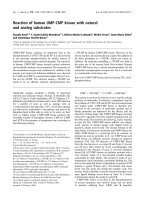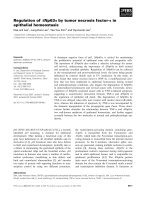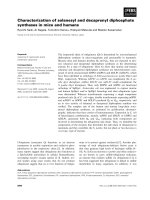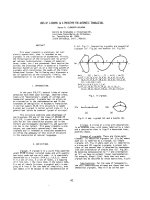Báo cáo khoa học: " Estimation of pulmonary capillary pressure: different methods for different pathophysiological processes" docx
Bạn đang xem bản rút gọn của tài liệu. Xem và tải ngay bản đầy đủ của tài liệu tại đây (30.94 KB, 2 trang )
143
ALI = acute lung injury; ARDS = acute respiratory distress syndrome; PCP = pulmonary capillary pressure.
Available online />Abstract
In the absence of a direct method with which to measure
pulmonary capillary pressure in humans, various methods for
analyzing the pulmonary artery pressure decay following balloon
occlusion have been described. In this issue of Critical Care,
Souza and coworkers investigate the adequacy of these methods
for assessing various pathophysiological processes. They studied
patients presenting with pathologies characterized by different
distributions of pulmonary vascular resistance. Their findings
suggest that no single method for estimating pulmonary capillary
pressure is adequate for all disease processes.
In healthy individuals pulmonary vascular resistance is low
and is mostly located within the pulmonary arterial bed. In the
absence of significant venous resistance, pulmonary capillary
pressure (PCP) is very close to the pulmonary arterial
occlusion pressure. Under these circumstances, pulmonary
arterial occlusion pressure may be used as a surrogate for
the pressure determining filtration from the capillaries to the
interstitium (PCP). However, this is no longer the case when
pulmonary venous resistance is increased, as may occur in
pulmonary hypertension of various aetiologies, acute lung
injury (ALI) and acute respiratory distress syndrome (ARDS).
In these patients PCP must be estimated by analyzing the
pulmonary arterial pressure decay after pulmonary artery
occlusion. Souza and coworkers [1] used this technique to
estimate PCP by different methods in patients with idiopathic
pulmonary arterial hypertension and with ARDS. These
authors addressed the fundamental issue of whether the
methods used to calculate PCP are adequate in different
disease processes.
In idiopathic pulmonary arterial hypertension, the massive
increase in pulmonary arterial resistance accounts for most of
the pulmonary resistance, even though some degree of venous
resistance is also present [2]. In these patients, the use of a
biexponential approach for the analysis of the pulmonary
arterial pressure decay after occlusion appears to be more
suitable than a monoexponential approach. A biexponential fit
provides an estimation of both the fast and slow components
of the pulmonary pressure drop, and therefore avoids
assumptions regarding the time needed for emptying of the
arterial compartment, which is markedly prolonged in this
pathophysiological situation [3]. A monoexponential fit starting
from 200 ms after occlusion may still include part of the
pressure trace resulting from emptying of the pulmonary arterial
compartment, as was suggested by the findings of Souza and
coworkers [1]. As discussed by those authors, extrapolation to
150 ms after occlusion for the calculation of PCP may for the
same reasons also be inaccurate, with values up to 199 ms
having been described in the experimental literature as being
more accurate in these circumstances [4].
Monitoring of both extravascular lung water and PCP may
help one to estimate the severity and avoid worsening of the
hyperpermeability lung oedema in ALI and ARDS [5,6].
However, the three-compartment model of the pulmonary
vasculature used by Baconnier and coworkers [7] as a basis
for estimating PCP may be inadequate in this clinical context
because of an increase in the resistance of the capillary
compartment, which is not taken into consideration by the
model. Moreover, this capillary resistance is not constant and
may vary throughout the course of the disease because of the
pathophysiological changes that characterize the disease
process [8]. Taking these limitations into consideration,
Collee and coworkers [9] reported successful use of this
model in severe ALI. However, data on the behaviour of
pulmonary artery pressure decay after balloon occlusion in
different stages of ALI/ARDS are scarce [10]. It is reasonable
to conclude that the three-compartment model may not be
Commentary
Estimation of pulmonary capillary pressure: different methods
for different pathophysiological processes?
Silvia Nunes
Department of Anesthesiology and Intensive Care, Tampere University Hospital, Tampere, Finland
Corresponding author: Silvia Nunes,
Published online: 17 February 2005 Critical Care 2005, 9:143-144 (DOI 10.1186/cc3060)
This article is online at />© 2005 BioMed Central Ltd
See related research by Souza et al. in this issue [ />144
Critical Care April 2005 Vol 9 No 2 Nunes
suitable at every stage of disease and/or that the methods
needed to estimate PCP may need to vary according to the
changing patophysiological characteristics of the pulmonary
vascular tree.
Estimation of the exact time of occlusion is a challenge during
measurements of PCP in humans. Respiratory noise is easily
avoided in artificially ventilated patients by maintaining an
end-expiratory pause during pulmonary artery occlusion. A
short period of apnoea may be possible in cooperative
spontaneously breathing patients. The variability due to the
cardiac cycle may be minimized by performing several
occlusions and choosing only those that occur during systole
[1]. Estimates of PCP based on these tracings have been
shown to be more accurate than those derived from
occlusions that occur during diastole [4]. However, the
steepness of the pressure decay after occlusion during
systole may lead to overestimation of PCP [9,11]. Although
the start of occlusion can easily be identified during systole,
the inflation of the pulmonary arterial catheter balloon is
always relatively slow, and accuracy (at least with respect to
the starting point of balloon inflation) could still be enhanced
by the use of a superimposed nonoccluded pulmonary arterial
pressure curve [9].
It is clear from the issues discussed above that estimation of
PCP in clinical practice cannot be based on a single method.
Further development of experimental models that are better
able to mimic clinical conditions may help in identifying the
most accurate methods with which to estimate PCP in each
clinical condition. More extensive clinical data on the
behaviour of the pulmonary vascular tree throughout different
disease processes are also needed. Until then, estimations of
PCP may still help with clinical decision making, but caution
is needed while interpreting individual findings.
Competing interests
The author(s) declare that they have no competing interests.
References
1. Souza R, Amato MBP, Demarzo SE, Deheinzelin D, Barbas CSV,
Schettino GPP, Carvalho CRR: Pulmonary capillary pressure in
pulmonary hypertension. Crit Care 2005, 9:R132-R138.
2. Chazova I, Loyd JE, Zhdanov VS, Newman JH, Belenkov Y,
Meyrick B: Pulmonary artery advenbtitial changes and venous
involvement in primary pulmonary hypertension. Am J Pathol
1995, 146:389-397.
3. Fesler P, Pagnamenta A, Vachiery JL, Brimioulle S, Abdel Kafi S,
Boonstra A, Delcroix M, Channick RN, Rubin LJ, Naeije R: Single
arterial occlusion to locate resistance in patients with pul-
monary hypertension. Eur Respir J 2003, 21:31-36.
4. Pellett AA, Johnson RW, Morrison GG, Champagne MS, deBois-
blanc BP, Levitzky MG: A comparison of pulmonary arterial
occlusion algorithms for estimation of pulmonary capillary
pressure. Am J Respir Crit Care Med 1999, 160:162-168.
5. Benzing A, Bräutigam P, Geiger K, Loop T, Beyer U, Moser E:
Inhaled nitric oxide reduces pulmonary transvascular albumin
flux in patients with acute lung injury. Anesthesiology 1995, 83:
1153-1161.
6. Martin GS, Eaton S, Mealer M, Moss M: Extravascular lung
water in patients with severe sepsis: a prospective cohort
study. Crit Care 2005, 9:R74-R82.
7. Baconnier PF, Eberhard A, Grimbert FA: Theoretical analysis of
occlusion techniques for measuring pulmonary capillary pres-
sure. J Appl Physiol 1992, 73:1351-1359.
8. Ware LB, Matthay MA: The acute respiratory distress syn-
drome. N Engl J Med 2000, 342:1334-1349.
9. Collee GG, Lynch KE, Hill RD, Zapol WM: Bedside measure-
ment of pulmonary capillary pressure in patients with acute
respiratory failure. Anesthesiology 1987, 66:614-620.
10. Nunes S, Ruokonen E, Takala J: Pulmonary capillary pressures
during the acute respiratory distress syndrome. Intensive Care
Med 2003, 29:2174-2179.
11. Hakim TS, Maarek JI, Chang HK: Estimation of pulmonary capil-
lary pressure in intact dog lungs using the arterial occlusion
technique. Am Rev Respir Dis 1989, 140:217-224.









